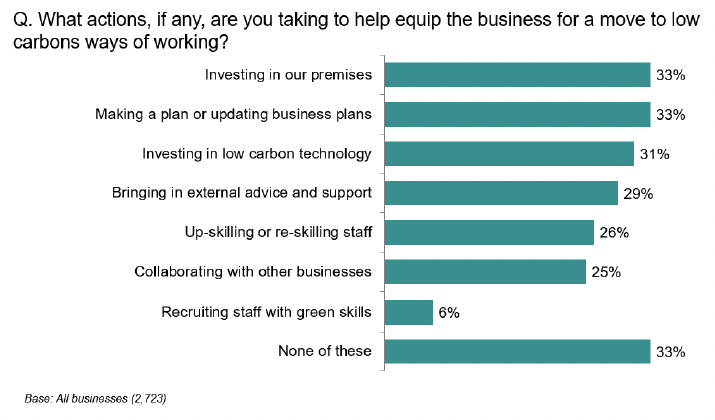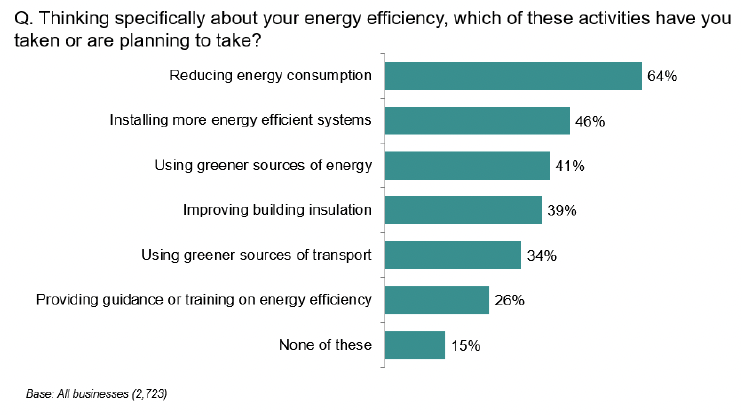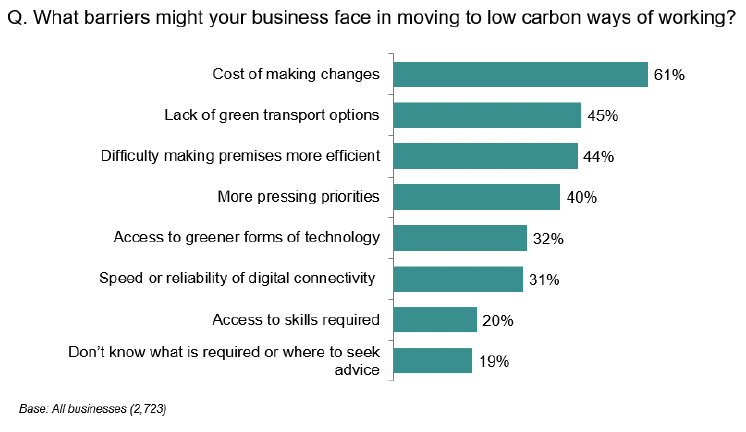Rural Scotland Business Panel Survey
This report presents findings from the second Rural Scotland Business Panel Survey carried out in February and March 2022.
7. Low carbon
Key findings
Two thirds (66%) of businesses were taking action to help them move to low carbon working. The most common actions were: investing in premises (33%), making a plan or updating business plans (33%), investing in low carbon technology (31%), and bringing in external advice and support (37%).
85% businesses were taking or planning actions to improve their energy efficiency. The most common action was reducing energy consumption (64%), followed by installing more energy efficient systems (46%), using greener sources of energy (41%), and improving building insulation (39%).
The most frequently mentioned barriers to moving to low carbon ways of working were: cost of making changes (61%), lack of green transport options (45%) and difficulty making existing premises more energy efficient (44%). These top three barriers were the same as those seen in the previous wave.
Actions to support low carbon working
Two thirds (66%) of businesses were taking action to help them move to low carbon working. Overall, taking action was more common than average among:
- food and drink (76%),
- tourism (75%)
- those with 25+ staff (86%) and
- those selling to markets outside the UK (71%).
The most common actions were: investing in premises (33%), making a plan or updating business plans (33%), investing in low carbon technology (31%), and bringing in external advice and support (37%) (Figure 7.1).

Variation in actions to support low carbon working
Businesses in the Highlands and Islands (73%) and the South of Scotland (71%) were more likely than those in the rest of rural Scotland (64%) to be taking actions to help them move to low carbon ways of working.
Some actions were more common among certain sectors:
- Food and drink – making a plan or updating business plans (49%), investing in low carbon technology (42%), and bringing in external advice and support (44%).
- Tourism – investing in premises (42%), bringing in external advice and support (36%) and recruiting staff with 'green' skills (11%).
- Those in the financial and business services sector were more likely than average to be taking none of the actions listed.
Businesses in remote rural areas and island businesses were both more likely to be taking the following actions:
- investing in low carbon technology (38% and 41%),
- investing in our premises (41% and 44%),
- making a plan or updating our business plan (38% and 41%),
- bringing in external advice and support (35% and 38%), and
- collaborating with other businesses (30% and 32%).
Energy efficiency
The majority (85%) of businesses were taking or planning actions to improve their energy efficiency. The most common was reducing energy consumption (64%), followed by installing more energy efficient systems (46%), using greener sources of energy (41%) and improving building insulation (39%) (Figure 7.2).

Variation in actions relating to energy efficiency
Tourism businesses were more likely than average to be taking each action (apart from using greener sources of transport), while food and drink businesses were more likely to be installing more energy efficient systems (53%), using greener sources of energy (50%) and improving building insulation (45%).
Large businesses (25+ staff) were also more likely than average to be taking several actions, specifically:
- installing more energy efficient systems (63%),
- using greener sources of energy (50%),
- using greener sources of transport (47%), and
- providing guidance or training on energy efficiency (44%).
Echoing the findings on low carbon working, remote rural businesses and island businesses were more likely to be taking a number of actions on energy efficiency, including:
- installing more energy efficient systems (51% and 58% respectively),
- using greener sources of energy (49% and 50%), and
- improving building insulation (44% and 50%).
International importers and exporters were both more likely to be using greener sources of energy (46% and 48% respectively) and greener transport (each 38%).
Businesses in the financial and business services sector were less likely to be taking any energy efficiency actions (18% were not taking any action).
Barriers faced when moving to low carbon ways of working
The most common barrier to moving to low carbon working was the cost of making changes (61%), followed by lack of green transport options (45%) and difficulty making existing premises more energy efficient (44%) (Figure 7.3). These top three barriers were the same as those seen in the previous wave (when businesses were asked about barriers to reducing their greenhouse gas emissions).

Variation in barriers to moving to low carbon ways of working
Remote rural businesses and island businesses were both more likely than average to mention most of the barriers listed (with the exception of lack of knowledge).
Other businesses were more likely to face specific barriers:
- Tourism – cost (72%), difficulty making premises more efficient (60%), access to greener technology (42%), access to skills (27%) and lack of knowledge (25%).
- Food and drink – cost (66%) and speed/reliability of digital connectivity (43%).
- Creative industries – speed/ reliability of digital connectivity (42%).
- Large businesses (25+ staff) – cost (73%), lack of green transport options (55%) and more pressing priorities (54%).
Contact
Email: socialresearch@gov.scot
There is a problem
Thanks for your feedback